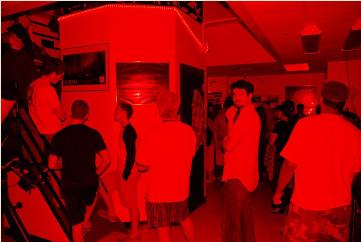|
|
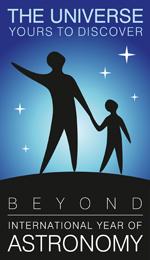
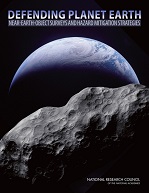
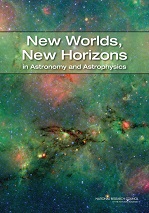
From
The National
Academies Press
New Worlds,
New Horizons in
Astronomy and Astrophysics
(2010)
It is the star to every wandering bark,
Whose worth's unknown, although his height be taken.
(Sonnet CXVI, lines 7-8, William Shakespeare)
Light Pollution Hurts the Night Sky for Astronomy
Coverage in this page includes:
- The Incredible Journey of Starlight
- Our Birthright, Stolen by Progress
- Astronomy, Our Perceptions of Light, and the Impact of Light Pollution
- Action Spectrum for Melatonin Regulation in Humans: Evidence for a Novel Circadian Photoreceptor
- Effects of Artificial Night Lighting on Terrestrial Mammals.
- White Light LEDs are Problematic for Human Circadian Systems
- The first World Atlas of the artificial night sky brightness
The Incredible Journey of Starlight
Typical starlight has a very difficult and violent birth.
Its parental atomic particles must have existed in an incredible furnace, with temperatures of at least 10 million Kelvin and central densities around twenty times that of iron, called a star's core. Only in those extreme temperatures and pressures, will these parental, positively charged particles be able to overcome their mutually repulsive electromagnetic forces and slam into each other at speeds of a few hundreds of kilometers per second. In doing so, they will lose a little bit of themselves, in the form of their combined mass. By Einstein's famous equation: E = mc2, their missing mass becomes a gamma ray photon that pops into existence.
As the stellar core is made of completely ionized gases, known as plasma, no electrons orbit any atomic nuclei, thus no atoms exist there that can capture and consume the newly conceived photon. But it does bang into other charged particles, new nuclei or free electrons that can convert its energy into higher velocities before expelling it again, and over and over It journeys on, passing through the core, whose densities quickly plunge as the photon nears its surface, and out to the next region in less than a second.
However, outside the core, lies a hostile jungle to the photon, it begins with the so called "radiation zone" of a star. Here, temperatures start to fall down to around eight million Kelvin. In this "cooler domain", electrons can now be electromagnetically bound to nuclei and together, temporarily become atoms. These atomic beasties devour all the gamma ray photons that the core produces, regurgitating them into ever more numerous, less energetic photons, over and over again. In this process, the initial gamma ray photon will have rapidly split up and multiplied into many generations of photons.
The photon generations make their way through the radiation zone until they come to the convection zone, where temperatures are now a much cooler two million Kelvin. The region's density drops considerably, freeing the atoms to move about. Here the photon generations are wholly consumed by the atoms which become caught up in the currents of the convective cells. The atoms rise up in currents of hot gases only to collide into cooler currents from above, causing them to release some of their captured energies as they then fall back down into the inner, hotter layers. In this way, the photon energies ride up and down the convective currents in sort of near endless, partner exchanging, square dance of layers of loop-de-loops. In our Sun's case, these loops range from 30,000 km in diameter, starting at 200,000 km below the photosphere, to every smaller circuits of 1,000 km in diameter just under the photosphere. All the while, the stellar atoms split the photons into a pattern of energies that is a signature of their elemental compositions. By the time the extreme energy from the initial gamma ray photon reaches the photosphere, it will have descended into millions of non-ionizing, weaker, visible photons, ending their gestation period and a million years will have passed.
At the photosphere layer, the medium's density is so low, it becomes optically transparent and those visible photons will then quickly pass through the stellar atmosphere. Here some of the atoms in the stellar chromosphere will have their last chance to capture photons of choice energies, preventing their release. The remaining photons that escape through that atmosphere, the majority that do not have such particular energies for capturing, will finally burst free of the star. And the starlight is born.
The starlight photon journeys onwards through space at the exacting speed of nearly 300,000 kilometers per
second, the legendary speed of light
. Depending on the distance of their origins, these photons may travel either a mere
8.3 minutes, for years or even up to millions of years on their way here. Very little is in their way to impede their travels,
that is, until they reach the thicker atmosphere of the Earth.
In as little as 1/3,000ths of a single second, these photons will get buffeted about by pockets of air of varying temperatures. Only then does the starlight end its journey in its final location into the back of our eyes and appear as a little twinkling sparkle in the sky. That when we see it, it calls to our mind a simple little poem by Jane Taylor (1783–1824) and makes us wonder what they are.
That is IF we can make it out against the confusing, and ever growing, luminous fog of artificial man-made photons called light pollution.
Our Birthright, Stolen by "Progress"
First, a question for you: Have you ever seen the wondrous band of light across the night sky called the Milky Way?
|
Sadly, the ever growing and more common answer will be no. And yet, this band of multi-colored, twinkling little lights and glowing nebulae is just right over your head most nights of the year. It is the beautiful galaxy of stars of which you and I are citizens of ever since the day we were born. It is a wondrous sight that adds to one's quality of life and is, in my opinion, ever greater than any national park we have on the Earth since it is so large and so very easily accessible by anyone. There should be no need to fly or drive to some exotic locale to see this phenomenon. You should just go outside at night, look up and enjoy its view! This view of the Milky Way Galaxy is so bright that, as Galileo himself once recorded, you can see your shadow by its light at night! Wait, you say, you have done that and you can't see any such band of light! Then you are a person who is suffering from the effects of light pollution, which some just shrug and say "Well, that's progress..." I find that callous and apathic attitude to be very strange. Are the oceans and their wondrous coral reefs something that only a marine biologist should have access to and be able to enjoy? Are the beautiful and giant redwoods something that considered to be only pre-lumber or pre-paper and in the way of progress? Is the Grand Canyon a place that can only be appreciated and used by geologists or should people just think of it as being the perfect place to fill up with all of our trash? Then why do we let the night skies become so filled up with trash light? As an astronomer, I am probably more acutely aware of light pollution and how debilitating it is for
viewing the stars, planets and nebulae that exists in space. Because of the way it directly affects me so, I have been more
concerned than most about the effects it has on us. For I feel that astronomy is not something that is done by people only after
hurricanes and power outages. I want to people to appreciate all the wonders the night sky offers us and to prevent the stars from
becoming another |
The 1994 Los Angeles-Northridge Earthquake -- The above statement is not at all overly dramatic. It
is a growing trend. The National Institute of Health's issue of the January 2009 Environmental Health Perspectives Journal
included a story from the 1994 Northridge earthquake which had knocked out the power in Los Angeles. Apparently local emergency
centers then had received numerous calls from anxious residents reporting a strange, giant, silvery cloud
in the
dark sky. What they were really seeing - for their very first time - was the Milky Way, so obliterated by the urban sky glow that
it had become forgotten and had practically become an urban legend.
(Environ Health Perspective 2009 January, Vol. 117, No. 1,
pages A20 - A27).
Ed Krupp, the director of the Griffith Observatory in Los Angeles, had reported that many callers did not
want to believe that what they saw when the power was out really was the normal, unpolluted, appearance of the night sky. He has
said that Since so many of us never see a non-light-polluted night sky from one year to the next, a mythology about what the
people think a true star-filled sky looks like has emerged.
An example of this from around here in South Florida is that during the night time, clouds are bright white, when in fact they should appear black against a black sky. I am amazed of how many of our visitors seem surprised by that fact, when I tell them it. Try to see a faint nebula, a comet or recognize a constellation against such competition and you'll realize why the first science, astronomy, is slipping away from people's consciousness. Please read on, for we seem to be determined to increase our blinded forgetfulness.
A nice thing about this "save the ..." effort is that it is something that anyone can do, such as make a one-time adjustment to your outside lights, and probably never need to anything else about it again. It really can be that easy.
"When you look at the night sky, you realize how small we are within the cosmos. It's kind of resetting of your ego. To deny yourself of that state of mind, either willingly or unwittingly, is to not live to the full extent of what it is to be human."
- astronomer Neil de Grasse Tyson, director of the Hayden Planetarium at the American Museum of Natural History in New York.
"I hear that it is an imperfect copy that I possess and have read, that my ancestors have torn out many of the first leaves and grandest passages, and mutilated it in many places. I should not like to think that some demigod had come before me and picked out some of the best of the stars. I wish to know an entire heaven and an entire earth."
- From the journal of Henry David Thoreau, March 23, 1856.
"Many people who come to our programs have never really looked at the night sky. A woman once came up to me and said, 'The Moon was out during the day this morning - is that O.K.?'"
- Chad Moore, the program director of the National Park Service's Night Sky Team
as reported by David Owen in The Dark Side, Making war on light pollution. The New Yorker.
(Note: for the record, the Moon is out during the day half the time of every month. We just don't notice as much because the day time sky is so bright and that we are looking at its dark night side, so it is not lit by the Sun. However, if you look at it soon after sunset when it is a very thin crescent shape, you may be able to see its night side! This is called "Da Vinci light", because it was the great artist Leonardo himself that figured out that the Moon's night side was being illuminated by the bright full Earth!
Astronomy, Our Perceptions of Light, and the Impact of Light Pollution
First to understand what it does, it is helpful to understand the
equipment we use to see the stars. And here, by equipment, I do not mean telescopes, I mean our own eyes. Our eyes use two light
receptive cells for viewing called rods and cones, so called because of the cells' shapes, and another type of light sensitive
cells, called photosensitive gangalion cells, that our bodies use to set or trainour circadian systems. Daytime vision uses cone cells, it is called photopic vision and operates at luminance levels from 1 to 106 cd/m². The cones come in three varieties, each of which detect light in particular ranges of spectra; blue cones predominate in the blue region of the spectrum, green cones predominate in the green and red cones in the red. Any color that we see and interpret to be some other named color (like "magenta" or "ochre") is realized by different intensities of the three primary colors. Night vision uses rod cells, which can sense a single photon of light, but only in the bluish-green region of the spectrum, its peak spectral wavelength is 498 nm. Called scotopic vision, it occurs at luminance levels of 10-2 to 10-6 cd/m². It only distinguishes brightness levels in light of that blue-green region, thus it is insensitive to the red region. In order for them to detect light, it needs to make use of a pigment that reacts to light called rhodopsin. Rhodopsin is what our bodies create when it uses vitamin A. At twilight levels or in the presence of too much blue light, rods saturate, for we simply cannot make rhodopsin fast enough. As they can no longer provide information to our brains, and so, we become night-blind. To avoid becoming night blind, we avoid blue light and operate in a red only, night mode, as seen in the picture to the right. |
|

A scale showing apparent magnitude limits of commonly seen objects.
Brightness -- Stars vary in their perceived brightness, not just because of their different distances,
but also because their varied outputs. The differences in brightness are described by the star's magnitudes, the larger the
magnitude's value, the dimmer the star appears. While this may sound backwards, the reason is historical. In 134 B.C. a new star
appeared in Scorpio. So, Hipparchus, a Greek astronomer, made a new catalog the stars. He recorded 1080 stars, by latitude and
longitude and defined them into orders of brightness. This catalogue was the basic standard reference for the next sixteen
centuries. (A Short History of Astronomy, Arthur Berry, 1898, Dover Publication, Inc. New York, 1961 Edition). 280 years
after Hipparchus, Ptolemy, another Greek scientist, gave them numerical values of magnitude to the stars did so according to their
perceived importance
or brightness of the star. The brightest stars, obviously
had to be a first order of importance
and hence got a magnitude of one, the stars that are a bit dimmer must have been the next order of importance, hence had the
magnitude of two, and so on. They were able to identify six orders of brightness in the stars, and the classification of magnitude
was created.
The problem is that the measurement was a bit subjective. One person might have said that a star had a magnitude of 2.9, while another described it to be 3.1. So in the modern era, magnitudes have been redefined so that a difference of five orders of magnitude equaled a exact 100-fold multiplier in brightness. Thus, +1.0 magnitude star is 100 times brighter than a +6.0 magnitude star. So then the brightness multiplier of a single increment in magnitude works out to be the fifth root of 100, which is just 2.512. The table to the right hints at how simple the math is to figure out the brightness multiplier for differences of apparent magnitude. First, "break apart" the app. mag. into multiples of five and whatever remaining mag remainder is left. Convert each "2.512 to the fifth power" factor to 100, and the remaining to their multiplier, then multiply them back together. As an example, convert a difference of apparent magnitude of 14 into its brightness multiplier:
Which is how much brighter the Sun (mv = 27) is compared to a typical full Moon (mv = 13). Nowadays, we can more easily measure a star's brightness using electronics. Of course, people can see that one star is brighter than another star. But if you were to ask them if they thought that the first star was many times the brightness of the other, most would say no, even if it is. For them, the many times brighter star could just be a couple of increments brighter in magnitude; however an electronic device will measure the actual photonic count to be. Or likewise, can you believe that it would take the light output of four hundred thousand full Moons just to equal the brightness of the Sun!?!? |
|
This means that as our eyes perceive brightness on a logarithmic scale, then doubling the amount of light is only perceived by us to just be a small increment or change in the light's magnitude. This is one of the reasons why increasing the amount of light often produces such futile results.
at the same rate as its electrical costs' increase.
Source: International Dark Sky Assoc. |
The impact of light pollution is to reduce our eye's limiting magnitude. That means that we can see fewer and fewer stars. The table at the left lists off about how many stars that we can see for a given limiting magnitude. As we can only see half the night sky for any given night, then we should only be able to see half those numbers for any given night. For an apparent magnitude limit of +4, the Milky Way galaxy can no longer be seen by the naked eye. Thus, people living under skies that have a limiting magnitude of +3, are truly robbed of what should be, by birthright, their ability to see a majestic wonder of the skies. What is especially amazing to me, is that this theft occurred only within the most recent one hundred years of human history and yet so many people are blindly ignorant of their loss. |
As to help illustrate the last point of the Limiting Apparent Magnitude of sky conditions, below is a nice graphic from Gizmodo.com about the differences in the number of stars that can be seen due to varying levels of background light pollution. Click on it to follow it to the original article. Lights on places to make a difference in the quality of life for so many people around it.
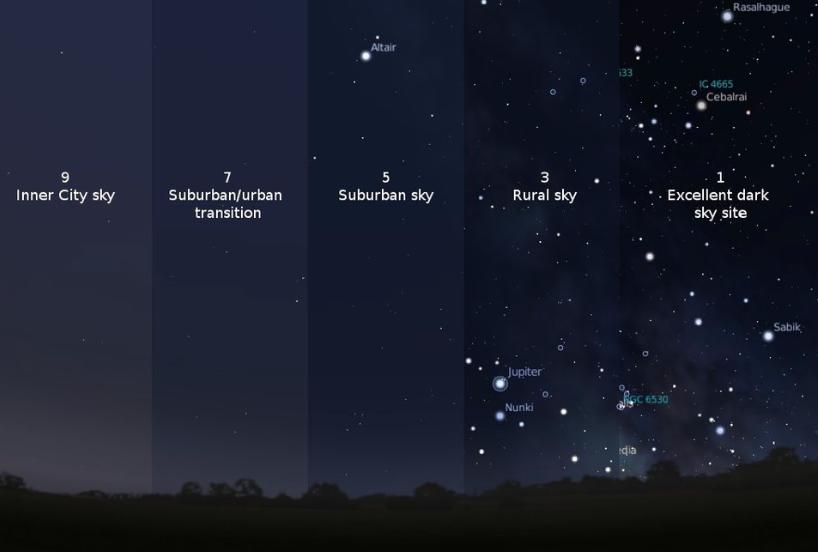
Is the closing of the sky a symbol of the closing of the urban mind? We are living in an era that has no great vision for any civilization other than commerce in China and India. Is humility an important ingredient in pushing mankind forward, does it beget the necessary ingredients of an advanced society, a vision? Yes I think so. As more and more people get closer together all that pollution of light and air dissolves any greater vision, and self obsession takes its place.
When the sky is washed clear of its character there is nothing but a skyscraper to offer humility, and if you live in one or work in one's humility goes quickly.
Great visions have great plans with great projects, the pyramids, the cathedrals of Europe etc, where is our great plan? Where is that project that is so grand it almost seems separate from us, greater then us yet achieved by all of us. I am not talking about more of the same that has come before but something so audacious, so risky, so powerful it could never come to being without our own personal visions invested in that great plan.
The sky beckons us and we fall deeper into ourselves. The caveman had a clearer vision of our place, yet he too fell into himself, thinking the sky was full of evil things just waiting to strike him dead. With the sky empty of its form and structure where is there room for vision, where is there a need to be something better than a caveman with a cell phone?
We need a project, we need a plan, we need a vision, we need to go to Mars.
--blub10/8/2010 - a replier to the above mentioned article.
Here are two papers that look into these aspects a bit more than the above. The first sought to further pin down what light effects our biological clocks and what is the light's receptors. The second covered the effect of light on the eyes of mammals. These are followed by a report by the International Dark Sky Association about the impacts of while light LEDs.
Action Spectrum for Melatonin Regulation in Humans: Evidence for a Novel Circadian Photoreceptor
Source: The Journal of Neuroscience, August 15th, 2001, Vol. 21, Issue 16, pgs 6405-6412.
George C. Brainard1, John P. Hanifin1, Jeffrey M. Greeson1, Brenda Byrne1, Gena Glickman1, Edward Gerner1, and Mark D. Rollag2
1Department of Neurology, Thomas Jefferson University, Philadelphia, Pennsylvania 19107
2Department of Anatomy, Physiology and Genetics, Uniformed Services University of Health Sciences, Bethesda, Maryland
20814
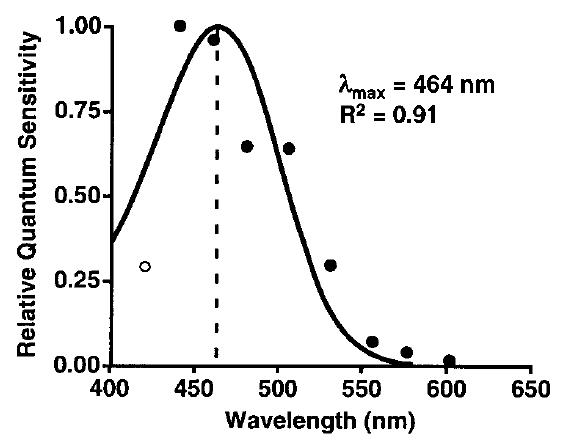 As of the paper, we did not
know what was the photopigment in our human eyes that signaled our biological clocks (the circadian system) and our neuroendocrine
system. In their work, the researchers did find the spectral region that suppresses melatonin production from the pineal gland.
To find this
As of the paper, we did not
know what was the photopigment in our human eyes that signaled our biological clocks (the circadian system) and our neuroendocrine
system. In their work, the researchers did find the spectral region that suppresses melatonin production from the pineal gland.
To find this action spectrum
, they analyzed blood for melatonin from 72 test subjects (mean age of 24.5 ± 0.3 years)
between the hours of 2 to 3:30 am, before and after the subjects looked at a monochromatic light source. Seven different
wavelengths of light ranging between 420 to 600 nm were exposed to the subjects, with a minimum of one week of rest between
exposures. The data collected fits curves that peak in the 446 - 477 nm spectral region. This wavelength region showed the strongest
effect on suppressing melatonin and regulating the circadian system.
The researchers believe that, in humans, a new single photopigment may be primarily responsible for melatonin suppression. They believe this for the pigment's peak spectral absorbing region does not match the peaks of the rod and cone cell photopigments typically used for day or night vision.
While they have not been given a name that is as easily learned as rods
or cones
, these cells
are being called photosensitive ganglion cells.
Effects of Artificial Night Lighting on Terrestrial Mammals.
Source: Ecological Consequences of Artificial Night Lighting. Catherine Rich & Travis Longcore (eds). 2006. Island Press. Covelo, California. Pages 15-42.
Northern Arizona University School of Forestry
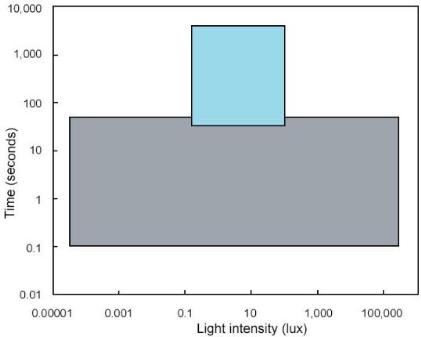 A section
of Beier's paper covers light's impact on biological clocks in mammals. Circadian systems or biological clocks range in time
periods of around 24 hours, typically 23 to 25 hours for most vertebrates to some extremes of 21 to 27 hours. (An adjustable
circadian system is probably a best fit adaptation to the waxing and waning of the night in different seasons.) Because a circadian
system is free running and its period may not be exactly 24 hours, it needs to be reset or
A section
of Beier's paper covers light's impact on biological clocks in mammals. Circadian systems or biological clocks range in time
periods of around 24 hours, typically 23 to 25 hours for most vertebrates to some extremes of 21 to 27 hours. (An adjustable
circadian system is probably a best fit adaptation to the waxing and waning of the night in different seasons.) Because a circadian
system is free running and its period may not be exactly 24 hours, it needs to be reset or entrained
to the local time by
some external cue. The cue vertebrates use to entrain their clocks, called a Zeitgeber
(literally Zeit
means time,
geber
means giver), is the change in light intensity and perhaps the spectral color of light at dawn and dusk. In
vertebrates, visual imaging cells, the rods and cones of the retina, do not entrain the circadian system, a different set of retinal
cells are suspected to do this. For the response characteristics of the imaging cells do not match the light conditions that the
circadian system responds to.
The graph plots the ranges to at which systems in vertebrates respond to light. The large grey box plots the range of light intensities and the time they can effect rod and cone visual imaging systems. The blue box covers the range which affects the circadian system. There is little overlap between the two systems. To adjust a biological clock, a brighter light for a longer duration (30 seconds to 100 minutes) is needed than what is required to form an image. This protects the circadian system from being reset by brief flashes of light, such as lightning, which are not reliable indicators of time.
The influence of light on the circadian clocks influences production of some hormones, notably melatonin, which mediates almost every physiological or behavioral rhythm in mammals (Bartness and Goldman. 1989. Mammalian pineal melatonin: a clock for all seasons. Experientia 45:939-945). In all species, melatonin production is high at night and suppressed during daytime, although reaction to melatonin often differs between diurnal and nocturnal species. Among its many roles, melatonin suppresses tumor growth by regulating production and tumor use of linoleic acid. More about this effect is listed in the light pollution verses mammals of our environmental pages and on human health pages.
White Light LEDs are Problematic for Human Circadian Systems
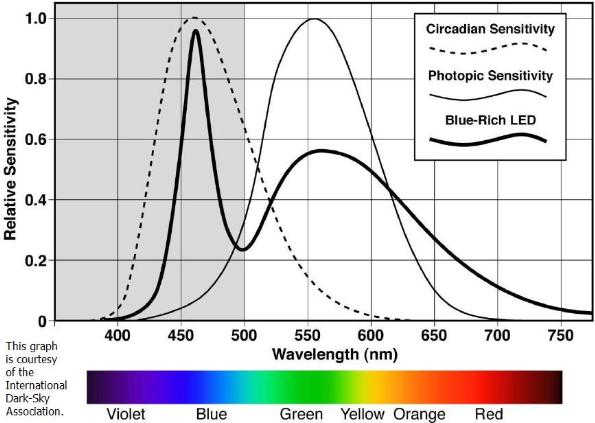 I normally consider myself to be among those who would
be the first in line to argue and work for improved energy efficiencies. This is why I find the next piece of information to be so
disturbing. It serves as a warning about the new white-light LEDs that should be grabbing an ever increasing market share of the
lighting business. Because of their blue light output component is so strong, and because our atmosphere most efficiently scatters
blue light (called
I normally consider myself to be among those who would
be the first in line to argue and work for improved energy efficiencies. This is why I find the next piece of information to be so
disturbing. It serves as a warning about the new white-light LEDs that should be grabbing an ever increasing market share of the
lighting business. Because of their blue light output component is so strong, and because our atmosphere most efficiently scatters
blue light (called Rayleigh scattering
hence the reason the sky is blue), then using more and more of these would increase
the amount of blue light about at night and so increase the problems that blue light causes for humans and animals.
LEDs have been around for some time now. So if energy efficiency was the only thing driving this change, then low-pressure sodium lights would have been replaced by yellow LEDs some time ago. But because of our preference to see the world in only daytime lighting levels and full daytime color, we seem to be rushing to embrace something that is not entirely the best for us. The International Dark-Sky Association has put out a white paper about these new lights and their analysis of them. Their graph to the right points out how well the new blue-rich LED lights would interfere with our circadian system and our ability to get a good night's sleep.
Thus, care should be taken ensure that we are not harmed by our rush to progress. To help people make better lighting choices, so to improve all of our sleep, the environment and any viewing conditions of the heavens for yourself, your neighbor or someone miles away may want to enjoy, just remember this simple thought about the nighttime:
BLUE BE BAD.
So what does the light pollution do that is so bad? Astronomically, it decreases the signal-to-noise
ratio.
This means that, just like a fog, the artificial
light washes out and obscures faint fuzzy nebulae, galaxies, and even the stars that should be seen in the night sky. This
artificial fog of light noise
blocks/hides the stars that are so necessary to astronomy. Light can be a pollutant, for any
form of pollution is an undesirable change in the physical, chemical, or biological characteristics of the natural environment,
created about by man's activities. It may be interfering to nonhuman life. Pollution may affect the soil, rivers, seas, or
the atmosphere. Thus, the resulting long term effects of light pollution is just as hazardous to us, as well as the environment,
as a chemical spill would be all across our land. (However, unlike a one-time chemical spill, we go back and consume ever more
energy resources just to recreate the same pollutant, night after night!) So light pollution is a true pollutant, for it alters
the natural quantity of light in the night environment due to the introduction, incorrectly installed and used artificial lights.
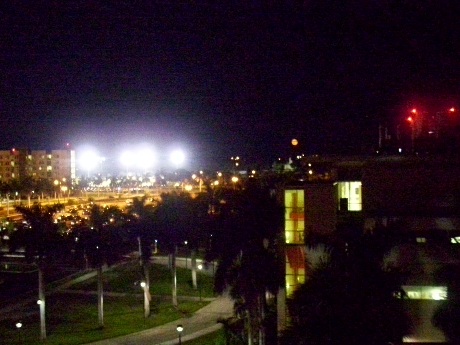 We, in South Florida, should take this
into account. As it is so warm down here in South Florida, we do a great deal of our activities after dark. Hence, field
athletic activities often take place in the evening or even into the night hours. It is the lights of those fields that
can be disrupting to others.
We, in South Florida, should take this
into account. As it is so warm down here in South Florida, we do a great deal of our activities after dark. Hence, field
athletic activities often take place in the evening or even into the night hours. It is the lights of those fields that
can be disrupting to others.
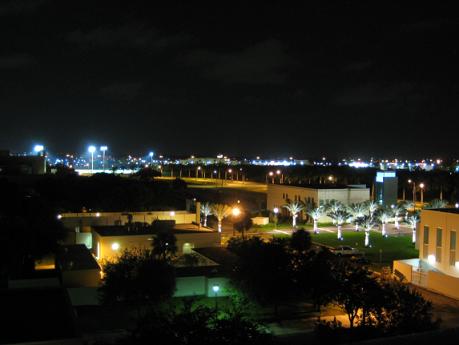 As an example, these two images to the right are of athletic fields nearby our dome. The first field has its
lights pointed outwards and is intensely discomforting, almost bordering on disability levels. Its glare trespasses in all
directions and is debilitating to our astronomical studies. As a means of self-protection, eyes naturally adapt to the brightest
objects in view. They do so by constricting the pupil's opening (or optically they
As an example, these two images to the right are of athletic fields nearby our dome. The first field has its
lights pointed outwards and is intensely discomforting, almost bordering on disability levels. Its glare trespasses in all
directions and is debilitating to our astronomical studies. As a means of self-protection, eyes naturally adapt to the brightest
objects in view. They do so by constricting the pupil's opening (or optically they stop-down
the eyes' aperture). Because
of this constriction, seeing faint objects around you or in the sky are much harder to do in the presence of the contrasting bright
lights. In the observatory, we have to alter our schedule, and of course our students' and visitors' schedules, just to work
around this light pollution, but we only get one night in the week to do so and yet a lot of students to teach, which seems
extremely unfair as I can say that our observations would not be as disrupting to their athletic activities, as their activities
are to our observations.
The light from the field is so bright that there is nothing in the sky that one can see above the field, with
the exception of a little orange ball to the right of the picture's middle. If you hover your mouse cursor over the image, you'll
be alerted to this little orange ball and find out it is the full moon, as taken on Sept. 13th, 2011. The field lights appear many
times brighter than the moon. Then consider that our eyes see light logarithmically, which means that if the field lights appear
that bright, then they are orders of magnitude brighter.
The next image is of a newer field which has its lights pointed downwards; its light beams demonstrate their direction. Even though there are many more lights, some poorly oriented nearby and others in the distance (I-95 and the airport), our eyes and the cameras are not so stopped down that one can even see some of the distant clouds in the picture. The glints of light that bounce off some of the field's light shields are nowhere near as blazingly bright as the first field emits. Note that both fields are about equidistant from our dome, though they were taken on different nights.
The highest happiness of man is to have probed what is knowable, and to quietly revere what is unknowable.
-- Johann Wolfgang von Goethe
Another result of light pollution is that is can help bring about civilization's death. Now first of all, I am the first to admit that this scenario is unlikely. However, even if it is an unlikely event, since it is such a catastrophic event, it needs to be said, because evidence from all over the world shows that it does happen. That event is extraterrestrial impact on the Earth.
On June 30, 1908 at 7:14 a.m. local time, something happened in the atmosphere above the deep taiga forests of central Siberia near the Podkamennaya Tunguska River.
"The sky split into two. Fire appeared high and wide over the forest... From... where the fire was, came strong heat... At that moment I became so hot that I couldn't bear it, as if my shirt was on fire... I wanted to tear off my shirt and throw it down, but then the sky shut closed, and a strong thump sounded, and I was thrown a few yards... After that such noise came, as if... cannons were firing, the earth shook." - Semen Semenov, local farmer.
Semenov was 65 km (40 miles) from "ground zero". The sound was heard in 1400 km away and Londoners supposedly felt the wind from the event. Due to light reflected off of massive, silvery clouds, Londoners could also read newspapers at midnight without artificial lights.
 Today, the only capability that we have to stop something like this from happening exists in Hollywood movies. We do
have the intelligence. We do have the technical capability and expertise. We are trying to detect the threats to our planet, but
we do not have the capability to do something about it. Remember, the dinosaurs are not here today because they did not develop a
space program. It would be an extraordinary loss for the planet, and be embarrassingly shameful for us co-called most intelligent
species on the planet, if something like that did occur and we were not ready for it.
Today, the only capability that we have to stop something like this from happening exists in Hollywood movies. We do
have the intelligence. We do have the technical capability and expertise. We are trying to detect the threats to our planet, but
we do not have the capability to do something about it. Remember, the dinosaurs are not here today because they did not develop a
space program. It would be an extraordinary loss for the planet, and be embarrassingly shameful for us co-called most intelligent
species on the planet, if something like that did occur and we were not ready for it.
To get a good feeling of what we have to deal with in our neighborhood in space, take a look at this YouTube video of Asteroid Discoveries and their pathes from 1980-2010 made by Scott Manley and please watch it all the way to the end. The orbital elements were taken from the 'astorb.dat' data created by Dr. Edward Bowell and associates at http://www.naic.edu/~nolan/astorb.html. the observation are supplied by The Minor Planet Center and the Lowell Observatory. The music is 'Transgenic' by Trifonic. Originally the numbers are quite small, but in the 1990s what survey automation we have starts to help find what it out there. The red objects are the Earth crossing asteroids and the ones that come most uncomfortably close to us. Note that there are errors of uncertainty in these orbits and little gravitational tugs by planets or by other asteroids that an asteroid comes nears to happen continuously. By choosing to remain blind to the ever changing, shooting gallery that we live in, means that we won't know to take action when the next one comes.
The asteroid map at the right comes from Armagh Observatory. You can learn more about it at http://szyzyg.arm.ac.uk/~spm/neo_map.html.
"Did you see all of the stars in the sky after hurricane Wilma!?!"
- Private communication from hundreds of South Florida residents, over and over again, when remembering the power outages and the dark nights.
What is sad about such statements is that the speakers typically say it as if what they saw was an exotic view, not what they should be able to see on any given night of the year.
Please note: Astronomy
is not just something to enjoy only after a hurricane has passed overhead!
To fit the modern times we live in, here is a suggested updated version to an old poem.
the last light I'll see tonight.
I wish I may, I wish I might
see the sky, that's hid from sight.
The Growth of "Just Another Light ... "
Light pollution is a hard concept to tackle as most people believe that light is benign and that one more additional light outside will not be noticed. This is not true. In some areas of the world, the growth of light pollution exceeds seven percent per year! That's a doubling of light pollution every ten years. And the steady growth of just another light takes its toll as the next article by Cinzano, Falchi, & Elvidge will show.
The first World Atlas of the artificial night sky brightness
Source: Monthly Notices of the Royal Astronomical Society, 2001, Volume 328, Issue 3, Pages 689 - 707
P. Cinzano1,2, F. Falchi1,2, and C. D. Elvidge3
1Dipartimento di Astronomia, Università di Padova, vicolo dell'Osservatorio 5, I-35122 Padova, Italy
2Istituto di Scienza e Tecnologia dell'Inquinamento Luminoso (ISTIL), Thiene, Italy
3Office of the Director, NOAA National Geophysical Data Center, 325 Broadway, Boulder, CO 80303, USA
Website: http://www.lightpollution.it/indexen.html
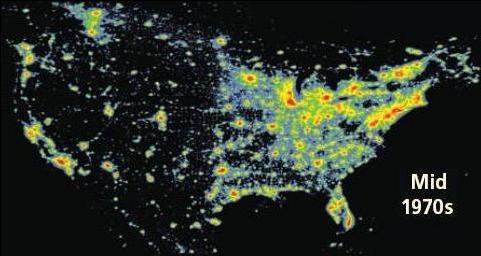 As people add more poorly aimed and unnecessary lights, the U.S. light pollution grows until not a single American will be able
to see the Milky Way or the stars. To the left are map images made by Cinzano, Falchi, and Elvidge that show the changes. The maps
shown are
As people add more poorly aimed and unnecessary lights, the U.S. light pollution grows until not a single American will be able
to see the Milky Way or the stars. To the left are map images made by Cinzano, Falchi, and Elvidge that show the changes. The maps
shown are Artificial night sky brightness at sea level for North America
. Each maps has been computed for the photometric
astronomical V band, at the zenith, for a clean atmosphere with an aerosol clarity coefficient K = 1. The calibration references the
years of 1996 - 1997. Country boundaries are approximate.
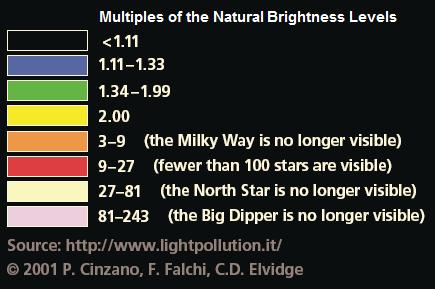 Pass your mouse cursor over the map to see how the change erodes our skies
over the decades. The U.S. light levels are based on upward light measured by the Defense Meteorological Satellite Program after
accounting for propagation and scattering of that light in the atmosphere. Levels correspond to a fraction of a referent natural
sky brightness (251 μcd/m2). The year 2025 map assumes a constant light growth rate of 6% per year, which is based on
measurements taken by satellites in orbit. That means that the amount of light doubles about every 11 year 8 months.
Pass your mouse cursor over the map to see how the change erodes our skies
over the decades. The U.S. light levels are based on upward light measured by the Defense Meteorological Satellite Program after
accounting for propagation and scattering of that light in the atmosphere. Levels correspond to a fraction of a referent natural
sky brightness (251 μcd/m2). The year 2025 map assumes a constant light growth rate of 6% per year, which is based on
measurements taken by satellites in orbit. That means that the amount of light doubles about every 11 year 8 months.
Image
Credits: P. Cinzano, F. Falchi, C. D. Elvidge. Copyright 2001 ISTIL, Thiene.
Reproduced from ISTIL Report 2001.
Note that I used the 1970 map from here to correlate with the map of breast cancer incidences by U.S. counties that Blot, Fraumeni, & Stone made back in 1977. The brightest regions, those with excessive amounts of light pollution such as cities, that Cinzano plotted match quite well with the counties that Blot mapped which had the greatest rates of breast cancer. Note that Blot, et al.'s map does not simply count higher numbers of breast cancer cases due to the higher populations, but it reports higher percentage rates of breast cancer in particular locations, which are these counties were printed darker than other regions.
This is the result of ever more additional lights pointed upwards into the sky. The light pollution sources are numerous. Examples of poorly directed lights include:
- those lights projected on to billboards or highway road signs
- or worse are some newer all electronic billboards that blast out their own light with useless messages that are too fleeting to read or remember
- lights projected up onto walls of various buildings, this makes the builders' feel important, government buildings commonly do this
- lights projected upwards to illuminate the undersides of trees
- various types of globe bombs, unshielded lights or neon lights
- upward pointing searchlights to signal a grand opening event (as if any of us ever actually followed those lights to see what is new??!? What a waste!)
- any type of bluish-white mercury fluorescent lights, their color is very obstructive to seeing emission nebulae in the sky or to recover one's night vision from
- outward pointing stadium/field lights
- lights pointing upwards to flags, a better alternative is to point the light downwards from the brass ball on the top, and there are vendors that can help you do this
Advertising: - There are those who say that the freedom of speech combined with the pursuit of profit ensures the creation of commercial advertising. Thus, they argue, we should just accept it. But we do not have to accept it. We can chose NOT to have shoved down our throats or into our minds someone else's continuous stream of commercials. Consider these videos of the result of more and more digital billboards. This video by ScenicAmerica focuses on the threats to our cities (and, I believe, our peace of mind) posed by uncontrolled outdoor advertising and commercialism. And the next is of what it would look like if electronic billboards look if they replaced static signs on our highways or roads. It seems to me that these sign down here are near locations of low income homes, as if they need yet another type of pollution dumped on them. Legislations need to be passed to prevent these signs from trying to bother us.
So what lights could one use? First, think hard about whether the light really is even needed at all. Note that this asks to consider other people affected by the light, not just what you believe to be your own needs. Next, the best lights to use which our biological systems do not react to and does not interfere with astronomy are those that avoids the blue end of the spectrum, such as shielded low-pressure sodium lights. Their near monochromatic nature means that all of their light at a very narrow band of yellow wavelengths which does not typically occur in space and hence can easily be filtered out at the telescope. High-pressure sodium is next best. A large range of lights that overlap those colors produced by astronomical sources, such as those produced by white or bluish mercury fluorescents should be avoided. However, more important than the light's color is how and when the light is used. Shield the lights so that the light's source can not be directly seen from above its horizontal plane. And turn the lights off after 11 p.m. when folks are asleep anyway. Get a good night sleep, there are health reasons for this and dark nights are not as bad as a security risk as one may think.
Florida Atlantic University
Boca Raton, Florida
E-mail: evandern at fau dot edu
Phone: 561 297 STAR (7827)
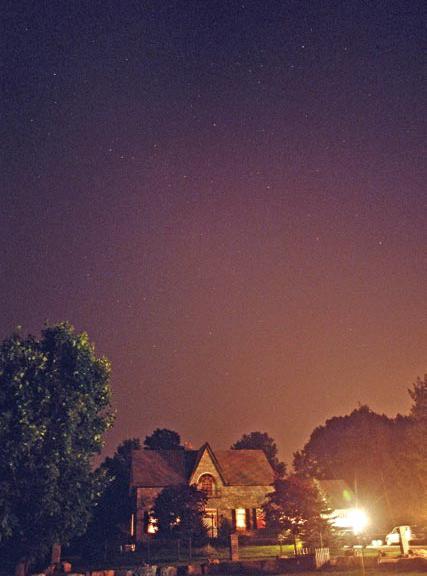 Note the bland and
boring sky with the unshielded "glare-bomb" lights combined with other distant light pollution sky-glow above this house in
Goodwood, Ontario. Note how much more interesting the sky was during the blackout of Aug 14th, 2003 the day before, even with
the candle light glowing from inside the house. In dark conditions, a person's dark-adapted eye can see the light of a candle
from over 10 miles away. As we are so sensitive to light, intelligently well-placed, low wattage, shielded lights are all that's
needed to achieve both security and interesting skies! Todd Carlson photographed the Milky Way during the blackout and a day
later once power was restored
Note the bland and
boring sky with the unshielded "glare-bomb" lights combined with other distant light pollution sky-glow above this house in
Goodwood, Ontario. Note how much more interesting the sky was during the blackout of Aug 14th, 2003 the day before, even with
the candle light glowing from inside the house. In dark conditions, a person's dark-adapted eye can see the light of a candle
from over 10 miles away. As we are so sensitive to light, intelligently well-placed, low wattage, shielded lights are all that's
needed to achieve both security and interesting skies! Todd Carlson photographed the Milky Way during the blackout and a day
later once power was restored